
This is my fourth post in my eight post series about implementing book clubs into your classroom. Last week, I wrote about Matching Books to Readers, which you can read more about HERE. Today, I am writing specifically about how setting high expectations will help your book clubs be a success.

How do you set your students up to be successful for success with book clubs? How do you keep your sanity when implementing book clubs? How do your students KNOW what to do and what will happen if they don’t do it? With these questions in mind, I implement the following strategies to encourage high expectations from all book club members.
- Book Club Bonds
During my whole class mini-lesson, I explain the “non-negotiable” expectations of book clubs:
– We will stay on task and talk about the book.
– We will come prepared to all group meetings
– We will cooperate when all group members, even if we do not share their opinion.
– We will participate in the group discussion by listening when others are speaking and adding our own opinions.
When book club members meet, they review the expectations and write any other expectations that they agree is important.
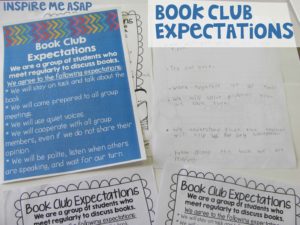
Some other expectations that groups added:
- Focus on the book and don’t talk about other things.
- We will get along and not fight.
- Try our best.
- We will work together to solve problems when we have them.
- We understand that the teacher will help us for only emergencies.
- Have a positive mindset.
Those expectations are added to the list. Each group member signs their name and writes the date, officially agreeing to the expectations. I photocopy the signed expectations for each group, sending one copy home and keeping the other copy in their reader’s notebooks.

My groups also agreed on a consequence for what happens if/when a group member does not follow agreed-upon expectations.
- Book club members are problem solvers
As my whole-class mini-lesson, I explicitly teach my students how to be problem solvers. We discuss common issues that may arise and brainstorm possible solutions. Together, we create an anchor chart that lists common problems and solutions that book club members might encounter.
Common problems that might occur during book club meetings are:
- What is a member is absent?
- What if you disagree with a member?
- What is someone is reading ahead?
- What is someone is not participating?
- How will you know how much to read?
- What if you can’t agree on a book?
When students meet with their book club, they discuss any problems they may have already had and ways they learned to solve them. Club members also discuss what the consequence will be, such as sitting out the meeting to catch up on the unfinished reading and/or writing.
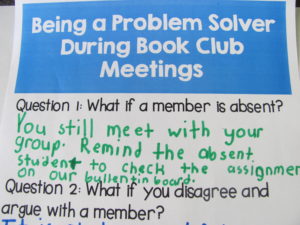
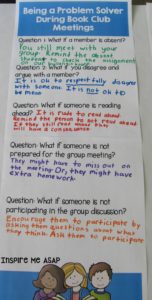
I keep this poster up as an anchor chart so the students can refer back to it throughout a round of book clubs.
- Book club materials
Book club members agree on a set of materials to bring to each meeting. As a class, we agreed that the book club book, book club booklet, a pencil, and sticky notes were all mandatory materials to bring to every club meeting.
Each club also met and agreed on any other additional materials that they felt necessary. For example, one group thought was a good idea to create and bring bookmarks and another group felt it was important to bring their reading folder with all of their materials.
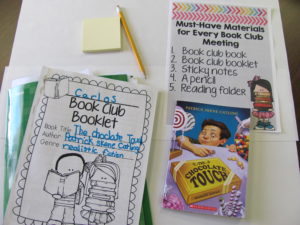
- Create powerful anchor charts
I love using my Smartphone to take pictures of my students when they are doing their best work. When I see my students actively participating, using respectful behaviors, and coming prepared with their materials, I take a picture of them in action. After printing up the pictures, I post them on our anchor charts. This is an easy way to reinforce the positive behaviors I see, as well as remind the members about the expected behaviors.
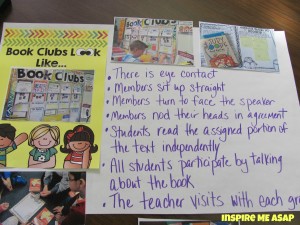
- Show, don’t tell
Another idea to help set high expectations for book clubs is to have former students model what they look like and sound like. I ask a fourth grade teacher if some of my former students can model an example of book clubs. My current students get a kick out of watching my former students “show off” their listening and speaking skills and stay on task discussing a chapter in the book.
- Book clubs have a routine.
Teachers know the importance of creating routines with their students. We are exhausted at the start of every school year because we are teaching the expectation for every possible procedure- going to the bathroom, taking attendance, walking in the hall, turning in papers, ect . Students are successful when they know exactly what to do.
Routines are also extremely helpful when implementing book clubs. Members discuss the “in’s and out’s” everything they need to know. This might include:
- Creating a calendar that lists the days the book club meets
- Creating a system to organize books and book club materials
- Knowing what to do if a member is absent
In my next post, I will explain how to hold your students accountable with book clubs. As always, if you have any questions, please email me or leave a comment on this post.

Chapter One: Introduction to book clubs
Chapter Two: Benefits of book clubs
Chapter Three: Matching books to readers
Chapter Four: Book club expectations
Chapter Five: Accountability with book club members
Chapter Six: Student-led conversations in book clubs
Chapter Seven: Role of the teacher in book clubs
Chapter Eight: Using assessments in book clubs
Looking for a resource to help you implement book clubs in your classroom?
Check out my resource below:

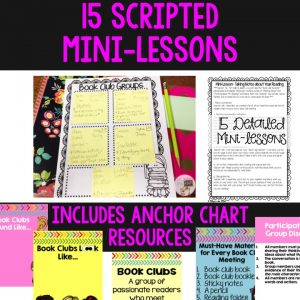
Looking for an engaging and sure-fire way to motivate your readers? This 107 page file has everything you need to know in order to effectively implement a book clubs with your rockin’ readers, while meeting the CCSS for Speaking and Listening.
There are 15 mini-lessons that are included in this file, which focus on establishing routines and setting expectations for book clubs with your students.
Mini-lessons include:
Detailed lesson plans
Colorful posters for you to print for your anchor charts
Reproducibles for your students
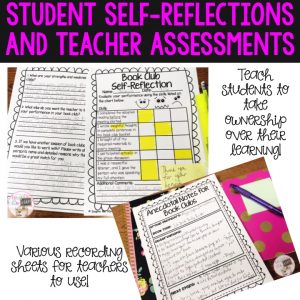
During this unit, readers will learn to:
-Define book clubs and understand its importance
-Describe characteristics of what book clubs LOOK like
-Describe characteristics of what book clubs SOUND like
-Book club members are assigned
-Commit to expected behaviors
-Shop for a book
-Follow agendas to stay on task
-Prepare for group meetings
-Read assigned portions of text and take notes about what they read
-Participate in a group discussion
-Share their opinions with group members
-Keep conversations on-task and focused
-Compromise and problem solve when issues arise
-Use prompts to guide their discussions
-Self-reflect and evaluate their performance
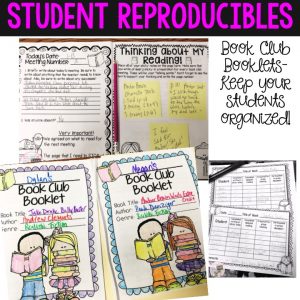
Also included in this unit:
-A note to send home to parents
-Tips for teachers about implementing book clubs successfully
-Detailed rubrics for teachers and students
-Bulletin board resources, where each group can post their group name, picture, assignment, and other important information
This Book Club Resource is also part of my Reading Workshop BUNDLE
Click HERE to purchase Book Clubs on Teachers Pay Teachers.
Save 10% by purchasing directly from my website.





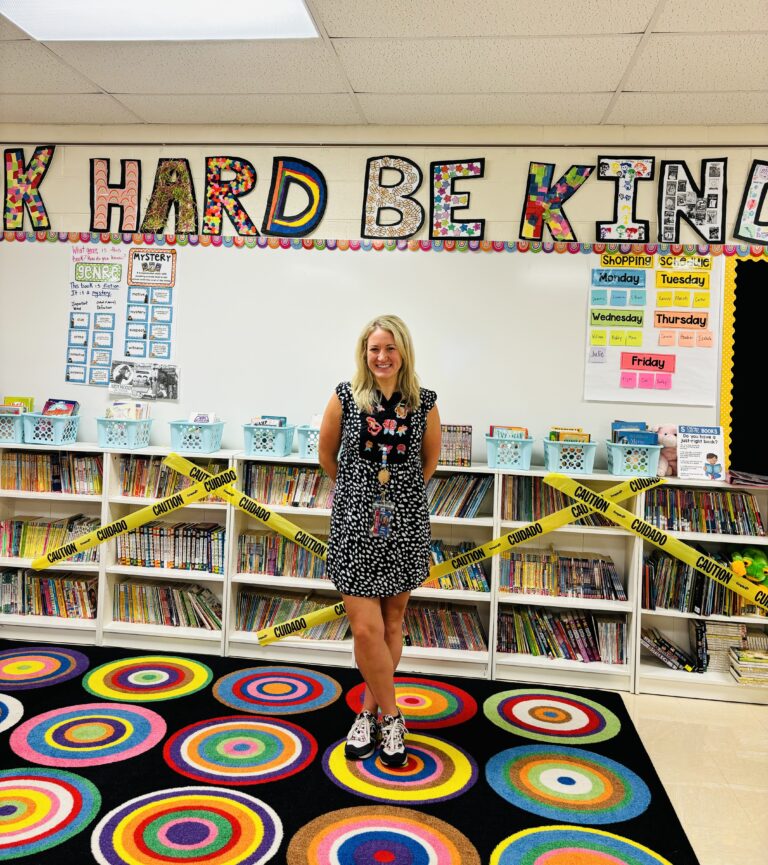



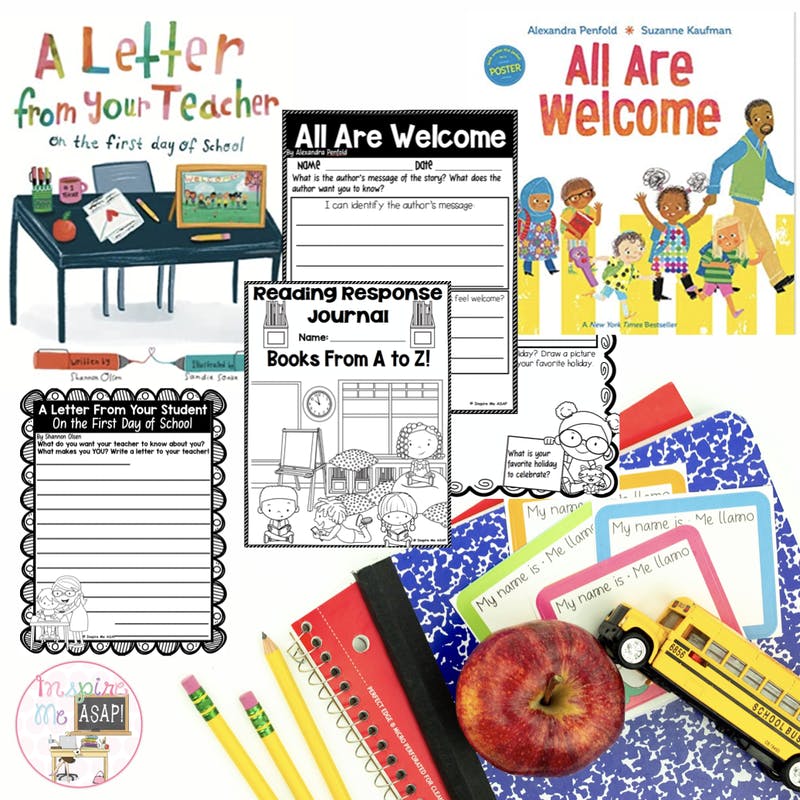
3 Responses
This has been an excellent read! Thank you for sharing!
I hope to do this in the 4th grade but I am coming from a 1st grade classroom. Do you teach just book clubs or do you also teach guided reading groups
Hi April,
Great question! I actually use book clubs AND guided reading, or strategy groups with my kiddos. However, when my students meet for book clubs, I usually one have time to meet with about one reading group. I implement book clubs during the second half of the school year, so for the first half of the school year I meet with more groups for in a traditional group setting. I hope that helps! Melissa :)